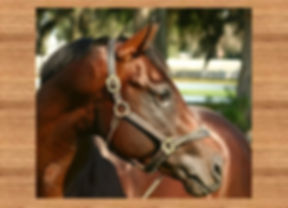Good Lesson from 2024
- sellison23
- Jan 3
- 4 min read
Updated: Jan 21

Pathogenes made good strides in our horse drug development and case analysis this year. Each case gives us insight into the disease process (pathogenesis) and what our new directions should be. That is why we always ask for feedback on your horse! The good news is we learned a lot from Nyambe and maybe you can as well. Nyambe was diagnosed with a life-threatening infection that has never been observed in a cheetah. When the scientific paper publishes we will put it in on our publications page and provide a link here.
Nyambe lives at Panther Ridge Conservation Center in Loxahatchee Fl. He came to the center when he was 12 weeks old to be raised as an ambassador for his species. We heard about Nyambe from one of our equine referring veterinarians, Dr. Diane Schiereck, in November '24 because he was very sick. She is familiar with our work and understands how to diagnose polyneuritis equi, she enrolled three horses in our clinical trial. Her question was: could our immune modulating treatment be useful in her patient Nyambe, who was struggling with pythiosis?
Knowing a bit about cheetahs is important to understand what a pickle Naymbe was in. He had severe infections in both hind legs— that were life threatening. The cheetah is an endangered species in the wild. Captive cheetahs suffer from stress related diseases, Helicobacter-associated gastritis kills many of them. They are particularly susceptible to infections that turn on the inflammatory response switch and they are unable to turn off the inflammation cascade once it starts. They can't turn off the pro-inflammatory pathway even if the cause of the infection is eliminated. Sounds a lot like Sarcocystis in some horses, doesn't it? Continuing to treat an organism that is no longer there ignores what is really wrong.
The result of a small worldwide population size for the cheetah is limited genetic diversity. Particularly important is their group of genes that are essential for the adaptive immune system, called the major histocompatibility complex (MHC). The adaptive immune system fights infections. Despite the low MHC diversity, the cheetah is immunocompetent! They compensate for their immune deficit by over activating the constitutive arm of adaptive immunity—that is inflammation. An out of control inflammation in the stomach (ulcers) kills many of them, as do infections with feline herpes virus.
Another adaptation of the dwindling cheetah population is the increased size of their adrenal glands and that gives them higher levels of corticosteroids. These chemicals alter the immune responses to infections by turning off mediators that coordinate and determine the appropriate immune response. It is this double whammy that Dr. S wanted to turn around, she asked if our drug could do that. And I believe it could. A drug we are developing is called FC-12738 and it is designed to regulated dysregulated pathways.
In September '24 Hurricane Helene dumped epic amounts of rain in Florida. The cheetah enclosure doesn't have a pond. However, storm runoff from Helene filled a nearby pond to overflowing and the water encroached into Nyambe's pen. The organism Pythium insidiosum resides in stagnant water in warm regions where it can infect wounds in mammals and people. The organism has never been described in a cheetah but is seen in horses—we call summer sores or "leeches". Doctors that don't have experience with pythiosis overlook the disease. It is notoriously rapidly progressing, itchy, and unresponsive to antimicrobials!

Nyambe's wound before cleaning is shown in this picture. After a month of bandage changes and antimicrobials there was mild improvement, but he wasn't out of the woods. Vaccination against Pythium was started. After 4 weeks there was a new eruption indicating the immune system was still hyperactive. Levamisole HCl (LEV) was added to the treatment, applied topically —with a noticeable difference in 3 days! There is a formulation of LEV available from Chile, but the dose seemed high to us and we know that product will have breakdown products that are pro-inflammatory when formulated as a solution.
Concerned about safety of LEV in a cheetah, we switched the immune modulation to FC-12738. This new drug is undergoing clinical trials in humans for amyotrophic lateral sclerosis (ALS) and no adverse events of concern were found in multiple species or humans. After undergoing treatment with FC-12738 Nyambe is healing well. His wounds are getting smaller and it looks like tissue grafts won't be needed. His bloodwork is improving.
This case gives us hope that FC-12738 will treat multiple diseases that are inflammatory, including neuroinflammation associated with ALS. But in this one case, Nyambe showed we can alter his abnormal Th1:Th2 balance (the fancy way to describe what is genetically and pathologically wrong). He most likely has Helicobacter-associated gastritis as well— so long as he continues to improve, he has a good shot at beating this cheetah-deadly disease as well. He is not only an ambassador for Panther Ridge Conservation Center but he may have contributed to the survival of his species. His experience may spur more research investigating the efficacy of adding modulating therapies to dysregulated immune systems found in cheetahs with Helicobacter-associated gastritis and herpes virus. He may have impacted the survival of his species as well as future treatment of human diseases. You can go and visit Nyambe in person, or donate on his website, his bandages and distracting treats are costly. Be sure and follow us at ndrinc.org as we continue to develop FC-12738 for people...and now maybe big cats!


